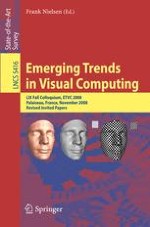2009 | Buch
Emerging Trends in Visual Computing
LIX Fall Colloquium, ETVC 2008, Palaiseau, France, November 18-20, 2008. Revised Invited Papers
herausgegeben von: Frank Nielsen
Verlag: Springer Berlin Heidelberg
Buchreihe : Lecture Notes in Computer Science
